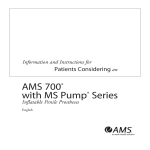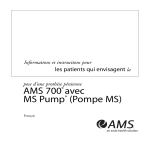Download AMS 700™ Series
Transcript
700FDA(cover).qkd
7/13/04
1:20 PM
Page 2
Information and Instructions for
Patients Considering an
™
AMS 700 Series
Inflatable Penile Prostheses
700FDA(cover).qkd
7/13/04
1:20 PM
Page 3
700FDA(guts).qkd
7/13/04
3:03 PM
Page 1
Table of contents
Topic
1.
2.
3.
4.
5.
6.
7.
8.
9.
10.
11.
12.
Page number
General warnings and cautions
1.1 How safe are silicone elastomer prostheses?
1.2 Will my prosthesis have to be replaced?
1.3 Need for manual dexterity
1.4 Possibility of malfunction
1.5 Possibility of changes in the penis or scrotum
1.6 Destruction of any latent natural erection
1.7 Different erection
1.8 Less softness when deflated
1.9 Possibility of infection
1.10 Delay intercourse until your doctor gives OK
1.11 Erosion
1.12 Pain
1.13 Migration
1.14 Allergic Reaction
What is impotence?
2.1 How does an erection occur?
2.2 Impotence is common
2.3 Impotence is treatable
Causes of impotence
3.1 Psychological causes
3.2 Physical causes
Am I impotent?
4.1 Impotence self-test
What to expect at your examination
5.1 Physical examination
5.2 Tests you may be asked to take
Treatment options for physical causes of impotence
6.1 Medication
6.2 Vacuum erection devices
6.3 Injections
6.4 Vascular surgery
6.5 Surgical implants
Description of the 700 series prostheses
What to expect during and after implant surgery
8.1 The surgical method
8.2 After your surgery
8.3 Problems that may develop
Operating instructions
9.1 Inflation
9.2 Deflation
Troubleshooting
Summary
Index
1
1
2
2
3
3
3
3
3
3
4
4
4
4
4
5
6
8
8
9
9
10
11
12
14
14
15
15
16
16
16
16
17
18
20
20
22
23
29
29
30
31
33
34
700FDA(guts).qkd
1
7/13/04
3:03 PM
Page 2
General warnings and cautions.
1.1
How safe are silicone elastomer prostheses?
The AMS 700™ Penile Prostheses Product Line devices are made of solid silicone
elastomers (a type of rubber). Penile prostheses, or solid silicone elastomers, do
not contain silicone gels. Silicone elastomers have been commonly used in
many different types of biomedical devices for over 40 years.
Solid silicone elastomers are also used to compare against when a new material is
being considered for use in a biomedical device. The new material is tested to see if
it is as biocompatible (causes as few problems in living tissue) as silicone elastomers.
Scientific literature has included reports of adverse events in some patients with
implantable silicone devices. These adverse events indicate allergic-like reactions
or autoimmune-like symptoms. (In an autoimmune reaction, the body’s own
immune cells may attack some or many of the body’s own tissues by mistake.)
However, even though these reactions or symptoms were seen in some patients,
there has been no proof that the silicone elastomer caused them.
Silicone elastomer may sometimes lose tiny particles off its surface after it has
been implanted. Sometimes these particles migrate (move) to lymph nodes in
other parts of the body where the particles then stay. (Your lymph nodes are a
normal part of your body’s defense system against infection.) Medical journals,
however, have indicated that particle migration has not resulted in any adverse
effects to a patient’s health.1,2
Fluorosilicone (a silicone fluid) is also used as a lubricant between internal
silicone elastomer and fabric layers in the cylinder to reduce wear. Silicone
fluids have a large history of use in medical devices, such as lubricating
hypodermic syringes.
Barrett DM, O’Sullivan DC, Malizia AA, Reiman HM and Abell-Aleff PC.“Particle Shedding and Migration from Silicone
Genitourinary Prosthetic Devices,” J. Urol. 146: 319-322. (1991)
2
Reinberg Y, J. Urol. 150: 694-696. (1993)
1
-1-
700FDA(guts).qkd
1.2
7/13/04
3:03 PM
Page 3
Will my prosthesis have to be replaced?
It is not possible to predict how long an implanted penile prosthesis will
function in a particular patient. As with any biomedical device, penile
prostheses are subject to wear and eventual failure over time, and therefore
should not be considered to be lifetime implants. Other causes can lead to
malfunctions of the prosthesis which occur more quickly. Discuss any changes
you notice in the function of the prosthesis with your doctor.
Product wear or other mechanical problems, such as unintended inflation or
deflation, or difficulty or inability to inflate or deflate may lead to additional
surgery to remove or replace the device.
Because it is not possible to tell how long an implanted penile prosthesis will
function in a particular patient, AMS has collected information on three sets of
data on device removals and revisions to help you understand product
performance over time.
The first data set comes from a clinical trial conducted for this penile prosthesis.
This data shows that approximately 84% of patients receiving an implant did
not require additional surgery (to remove or replace the prosthesis) for 5 years
after the original surgical implant.
The second set of data comes from Patient Information Forms (PIFs) submitted
to AMS by doctors after surgical procedures for penile prostheses requiring
replacement of parts.This data indicates that approximately 89% of patients
receiving an implant did not require any additional surgery (to remove or
replace the prosthesis) for 5 years after the surgical implant.
The third set of data comes directly from physician implant records.These
records contain information on each surgery for any reason performed by a
doctor after an original implant.This data set indicates that approximately 82%
of patients did not require any additional surgery (to remove or replace the
prosthesis for any reason) for 5 years after the original implant.
-2-
700FDA(guts).qkd
1.3
7/13/04
3:03 PM
Page 4
Need for manual dexterity
The AMS 700 prostheses require some manual dexterity to inflate and deflate.
1.4
Possibility of malfunction
The possibility of leakage, blockage, or device malfunction exists.
1.5
Possibility of changes in the penis or scrotum
Implantation of a penile prosthesis may cause the penis to become shorter,
curve, or be scarred. Scrotal deformity (pump bulge in the scrotum) may
also occur.
1.6
Destruction of any latent natural erection
Implanting a penile prosthesis is likely to damage or destroy any remaining
natural ability to have an erection.
1.7
Different erection
Your erection with the prosthesis may be different from your original, natural
erection. Differences may include a shorter penis, less firmness, less width, and
reduced sensation in the penis. Also, because the prosthesis will not extend to
the tip of your penis (the glans), this part of your penis may be floppy.
1.8
Less softness when deflated
When your prosthesis is deflated, your penis may not be as soft (flaccid) as it
was naturally.
-3-
700FDA(guts).qkd
1.9
7/13/04
3:03 PM
Page 5
Possibility of infection
Contact your doctor immediately if there is redness, swelling, and/or heat
around the incision area or drainage from the incision. This may indicate an
infection.
1.10 Delay intercourse until your doctor gives the OK
If you attempt intercourse before your incision has healed completely, you risk
the possibility of infection, pain, or surgical complication.
1.11 Erosion
Contact your doctor immediately if there is thinning of skin or tissue over the
prosthesis. This may indicate erosion. Failure to treat erosion can make it worse
and lead to infection and loss of tissue.
1.12 Pain
Contact your doctor if you have pain that is very severe or if it lasts longer than
expected. Such pain may be a symptom of a medical complication or
mechanical device malfunction.
1.13 Migration
Contact your doctor if the surface of any part of your device is visible through
your skin or if you cannot locate the inflate/deflate pump in your scrotum.
These symptoms may indicate that a part of your device may have moved
within your body or may be moving to the outside of your body.
-4-
700FDA(guts).qkd
7/13/04
3:03 PM
Page 6
1.14 Allergic Reaction
If you have a 700CX, 700CXM/CXR, or Ultrex device with InhibiZone™ and
exhibit symptoms of an allergic reaction, such as a rash, hives or difficulty
breathing, contact your doctor immediately. Because of this slight risk of
allergic reaction, you should be sure and inform your doctor about any allergies
you may have to antibiotics prior to your surgery.
2
What is impotence?
Impotence (also known as male erectile dysfunction) is the inability to maintain
an erection that is firm enough or that lasts long enough to have successful
intercourse.
Impotence:
• Is frustrating
• Has physical or psychological causes
• Is common
Impotence:
• Is not premature ejaculation
• Is not low sex drive
• Is not the need for manual or oral stimulation to get an erection
• Is not caused by too much sex
• Is not caused by masturbation when you were younger
• Is not connected to infertility
• Is not “normal” at any age
-5-
700FDA(guts).qkd
2.1
7/13/04
3:03 PM
Page 7
How does an erection occur?
For an erection to occur, several parts of the body must work together. The
brain sends messages to control the nerves, hormone levels, blood flow and
muscles that cause an erection. If anything interferes with one or more of these
messages, or if any part of the system doesn’t function correctly, an erection will
not occur.
The brain controls all sexual functions,
from being aroused to starting and
controlling the psychological,
hormonal, nerve, and blood flow
changes that lead to an erection.
Arteries deliver the extra blood to the
penis that causes it to stiffen. Veins
then drain the blood out of the penis
after intercourse.
Nerve impulses relay signals of arousal
and sensation to and from the penis.
Hormones, including testosterone,
control the male sex drive. Testosterone
is secreted by the testicles.
-6-
700FDA(guts).qkd
7/13/04
3:03 PM
Page 8
The flaccid penis
The shaft of the penis contains the corpora
cavernosa, two channels which run the full
length of the penis and into the pelvis.
These channels are rich in special blood
vessels which contain relatively little blood
when the penis is flaccid (soft, relaxed, not
enlarged). Without sexual stimulation, the
penis remains flaccid.
The tumescent penis
When the brain is sexually aroused, it
stimulates the nervous system to enlarge
the blood vessels in the corpora cavernosa,
making room for extra blood. The corpora
cavernosa absorb arterial blood flow like a
sponge. At this point the penis is swollen,
but not yet rigid (hard) enough for
intercourse.
The erect penis
As the corpora cavernosa continue to
absorb blood, the swelling puts pressure
on the veins in the penis. This traps the
blood in the corpora cavernosa, making
the penis rigid (hard).
-7-
Corpora
Cavernosa
700FDA(guts).qkd
2.2
7/13/04
3:03 PM
Page 9
Impotence is common
Most men occasionally have difficulty getting an erection. However, about one
in ten men are afflicted by chronic (continuing) impotence.
Impotence can be devastating to those affected by it. Unfortunately, it can also
be very difficult to talk about. But the first step is to seek professional help. If
your doctor regularly treats impotence problems, you can be sure that any
question you ask will be one he has heard before from other patients.
2.3
Impotence is treatable
In more than half of all impotence cases the cause is physical–the result of
diabetes, blocked arteries, a hormone problem, or other causes. In other cases,
the cause could be psychological–the result of stress or depression. And in
many cases, physical causes can produce psychological side effects.
Diagnosing the cause is the first step before recommending a treatment. Your
doctor will require a thorough history, physical examination, and laboratory
tests to determine whether the impotence has a physical or psychological
cause.
The good news is that there are treatments available. And there is usually more
than one option. Choices may range from sex counseling or marriage
counseling, to medical and surgical treatments. Your doctor can determine
which treatment alternative is appropriate for you. Most impotence problems
can be treated successfully.
-8-
700FDA(guts).qkd
3
7/13/04
3:03 PM
Page 10
Causes of Impotence.
3.1
Psychological causes
Depression can cause a lack of energy and a reduced sex drive. This may result
in an occasional inability to get an erection. If this happens, you may become
even more depressed. This can lead to impotence. The first step is to treat the
depression.
Stress can also result in an occasional inability to get an erection. Stress can be
caused by your job, marital, financial, or other situation. Like depression, this
inability to have an erection adds to the stress and can lead to impotence.
Performance anxiety (fear that you will fail if you try to have intercourse)
happens to most men once in a while. If it keeps happening it can lead to the
inability to have an erection and, ultimately, impotence.
Misinformation about sexuality and about how men should or shouldn’t be
able to “perform” at a certain age can lead to anxiety and stress, which can lead
to impotence.
To treat a psychological cause, your doctor may recommend that you seek
treatment from a qualified psychologist, psychiatrist, sex therapist, or marriage
counselor. Counseling can often resolve the psychological problem causing
impotence or be part of the recommended treatment. You and your partner
may wish to go through counseling together.
Even if the problem is physical, there may be psychological side effects.
Therefore, counseling may also be part of the recommended treatment for a
physical problem.
-9-
700FDA(guts).qkd
3.2
7/13/04
3:03 PM
Page 11
Physical causes
Diabetes can cause damage to the nerves or blood vessels that control the flow
of blood to the penis. In some cases, keeping your diet and blood sugar under
control can help. But permanent damage to these nerves and vessels may
result in chronic (continuing) impotence.
Cardiovascular problems, such as hardening of the arteries, can decrease the
blood flowing into the penis. This makes it difficult for you to get or keep an
erection. In other cases, the veins that keep the blood in the penis during an
erection are damaged. If this happens, you cannot keep the erection long
enough for sexual intercourse. Impotence can also occur if the nerves that
control this flow of blood to the penis are damaged by lack of blood.
Trauma (injury) or pelvic surgery, including cancer surgery in the prostate,
bladder, colon or rectal area, can cause impotence. In cancer surgery, the
surgeon’s most important goal is to remove all of the cancer. Nerves and blood
vessels that control erections may be near the cancerous tissue. Sometimes
these are damaged in an effort to remove the cancer.
Neurological disorders such as spinal cord injuries can cause impotence. The
spinal cord is the relay center for nerve impulses, brain messages and blood
flow. When the spinal cord is damaged in certain locations, messages can’t get
through to the nerves of the penis, causing impotence.
Medications may cause impotence by interfering with the nerve impulses or
blood flow to the penis. These medications include some prescriptions for high
blood pressure, depression and a number of other conditions. Sometimes a
change in the medication or the dosage will decrease the risk of impotence.
Caution: Medications should never be changed without the doctor’s
permission.
- 10 -
700FDA(guts).qkd
7/13/04
3:03 PM
Page 12
Alcoholism changes hormone levels and can lead to permanent nerve damage,
causing impotence. This type of impotence may be reversible, depending on
the severity of the nerve damage.
Hormone problems are rarely the cause of impotence, but certain diseases can
change the balance of hormones which control erections. Kidney failure and
liver disease are among these conditions.
4
Am I impotent?
If, after reading this, you are still questioning whether or not you are impotent
and what the cause may be, the following questions may indicate whether you
should consult a urologist, a doctor who specializes in treating problems
associated with the urinary tract. In general, if you answer “yes” to any of the
first six questions, you should see a urologist who specializes in the treatment of
impotence.
If your current doctor does not regularly treat impotence problems, you might
ask for a referral to a urologist who specializes in the diagnosis and treatment of
impotence.
When you see the urologist, share the answers from the following self-test. This
information will be valuable to the doctor as he or she determines a diagnosis.
Most importantly, you should know that continuing impotence is not a problem
that you should have to live with, or that will just go away. It’s important to
make a medical appointment as soon as the problem becomes apparent. It is
important so that you can help avoid the psychological problems that may
make it worse. Remember that impotence can be treated in almost every case.
- 11 -
700FDA(guts).qkd
4.1
7/13/04
3:03 PM
Page 13
Impotence self-test**
Current Sexual Performance
1.
Have you had any difficulty recently in achieving erections?
2.
Does this problem occur at least three out of every four times that you
attempt intercourse?
Sexual Performance Trends
3.
Have you been having difficulty for longer than one month in achieving
erections regularly?
4.
Are morning and spontaneous erections becoming less common?
5.
Does it take much longer to achieve an erection than in the past?
6.
Has it become more difficult to have intercourse in certain sexual
positions?
Medical History
7.
Have you ever been told you have any form of heart disease, especially
hardening of the arteries, peripheral arterial disease (PAD), or
hypertension?
8.
Have you ever had an operation for heart disease or some other
cardiovascular problem?
9.
Have you ever been told you have an elevated cholesterol level?
10.
Do you ever experience serious pain in the legs when walking?
- 12 -
700FDA(guts).qkd
7/13/04
3:03 PM
Page 14
11.
Are you taking any form of drug for a cardiovascular problem, especially
hypertension?
12.
Are you taking drugs on a prescription basis for any other problem?*
13.
Do you have any known glandular disorder, especially diabetes?
14.
Do you have any neurological disorder, such as multiple sclerosis
or epilepsy?
15.
Have you ever had major surgery in the pelvic area, especially surgery
involving the prostate gland or colon?
16.
Have you ever had an injury involving the pelvic area, back, spinal cord,
or head?
17.
Have you ever been treated with radiation therapy for a problem in the
pelvic area?
18.
Have you ever had an episode of priapism (an erection which lasts for
longer than usual and becomes painful)?
Lifestyle
19.
Do you now smoke or did you once smoke for a long period of time?
20.
Are you a heavy drinker or a diagnosed alcoholic?
21.
Have you used illegal drugs, especially cocaine?
22.
Are you a frequent user of drugs you can buy at the drugstore without a
doctor’s prescription?
23.
Are you excessively overweight?
- 13 -
700FDA(guts).qkd
7/13/04
3:03 PM
Page 15
If it is determined that you are impotent, and that your impotence is caused by
a physical problem, your doctor can offer several options for treatment. These
may include hormone therapy, injections, vacuum devices, penile implants, or
vascular surgery.
*Caution: Medications should never be changed without the doctor’s permission.
** Self-test questions are reprinted and edited with permission from Love Again, Live Again by Steven Morganstern, MD,
and Allen Abrahams, PhD.
5
What to expect at your examination.
5.1
Physical examination
Your doctor will ask you several questions in order to understand when and
under what circumstances you experience signs of impotence. Then your
doctor will give you a complete physical exam. This exam is to determine if the
blood vessels, nerves, and tissues of your penis are working normally.
Your doctor may begin by feeling for the pulse in
your penis and surrounding pelvic area.
This will give an indication if the blood supply
to your penis is adequate.
Your doctor must also perform a rectal
examination to check for prostatitis (a swollen
prostate gland). Problems with your prostate can
decrease blood flow and feeling in the penis.
Prostatitis can also make intercourse uncomfortable.
Your doctor will also check for physical abnormalities
such as Peyronie’s disease (a curved and painful
erection caused by scar tissue within the penis). He
will also check your history for previous injuries or
surgery in the pelvic area which may have caused
nerve damage.
- 14 -
700FDA(guts).qkd
5.2
7/13/04
3:03 PM
Page 16
Tests you may be asked to take
To confirm your diagnosis, other tests can detect hormonal abnormalities,
determine blood flow problems, and may help to rule out psychological
problems.
Blood tests and urine analysis
These tests are used to measure your hormone levels, cholesterol, and
triglycerides (to detect hardening of the arteries), and liver and kidney function.
To detect diabetes mellitus, a blood glucose test may also be requested.
Penile blood flow studies
Additional tests may be done to see how effectively blood flows into the penis.
One test involves an injection with a drug that increases the blood flow to the
penis directly, without stimulating the nerves in the penis. If the blood vessels
of your penis are healthy, this injection will produce an erection.
Sleep monitoring
Most men experience at least 3 to 4 erections each night
when they are dreaming. If you don’t have nighttime
erections, perhaps the nerve or blood supply to your penis
is inadequate for erections. Your doctor may ask you to
measure nighttime erections at home with a simple test
that he or she will provide.
6
Treatment options for physical causes of impotence.
Depending on your diagnosis, your recommended treatment may be medical or
surgical. Medical treatments range from simply changing your prescription
drugs, to hormone replacement therapy, antidepressant therapy, and devices or
self-injection therapy to produce erections. Surgical treatments include
vascular surgery or implants. Your doctor will discuss options that may be
appropriate in treating your impotence, as well as the risks and benefits of
each option.
- 15 -
700FDA(guts).qkd
6.1
7/13/04
3:03 PM
Page 17
Medication
Changing prescription medications or their dosages may
change the side effects, which may be causing your
impotence. Hormone replacement therapy may be
recommended if you have a hormone deficiency.
Antidepressant drugs may be the first course of treatment
if you’ve been diagnosed with severe clinical depression.
Drugs that increase the flow of blood to the penis to help
cause an erection are also available.
6.2 Vacuum erection devices
These devices are placed around the outside of the penis
and draw blood into the penis by creating a vacuum. Then
you or your partner place a constriction band (rubber
band) around the base of the penis to keep the blood
inside the penis until sexual intercourse is completed.
6.3
Injections
Injecting medication directly into the penis prior to
intercourse can also produce an erection. If you and
your doctor choose this option, you will be taught
how to administer the injections yourself.
6.4
Vascular surgery
For a few men, vascular surgery may be indicated to improve blood flow into
the penis. Leaking veins may also be surgically repaired. In cases where arterial
blockage is reducing blood flow to the penis, an arterial bypass around the
blockage may be recommended.
- 16 -
700FDA(guts).qkd
6.5
7/13/04
3:03 PM
Page 18
Surgical implants
Penile implants, or prostheses, may be a choice that lasts longer for a number of
impotent men, especially those who’ve tried psychological and other medical
treatments without success. Implants have helped over 250,000 men return to
an active sex life. Many studies show most patients and their partners are
highly satisfied with the results.
Implants are concealed entirely within the body. They require manipulation by
you or your partner before intercourse to make the penis firm enough for
sexual intercourse. Manipulation is also needed afterwards to return the
implant to a relaxed state (make it flaccid).
There are several types of implants to choose from. Differences include manner
of operation, naturalness of the erection, and the number of components
implanted. In choosing a penile prosthesis you should consider the manual
dexterity that is needed to operate each type of device. The best choice of
penile prosthesis for you will depend upon your medical condition, your
lifestyle and, possibly, the cost of each prosthesis.
Before deciding on a penile prosthesis, you should consult with your doctor
about the physical, psychological, cosmetic, and functional outcome of the
implantation surgery. You should be sure that you understand the risks and
benefits of the surgery.
There are certain instances when you and your physician may decide that a
surgical implant is not an appropriate choice for you if:
• the risks associated with surgery are too high because of your medical
condition
• your medical history includes previous surgery which make an implant
impossible
• you are satisfied with one of the less invasive treatment options
discussed in section 6
- 17 -
700FDA(guts).qkd
7/13/04
3:03 PM
Page 19
• you choose not to be implanted with a silicone elastomer device
• you want to preserve the internal physical structure of your penis in
case someday you may again experience a normal erection
In addition to discussions with your doctor, you may want to discuss the various
options with your partner.
7
Description of the AMS 700™ Penile Prosthesis Product Line
The 700 line prostheses consist of four parts which are connected by tubing: a
reservoir, two cylinders, and an inflate/deflate pump.
The reservoir is implanted in the lower abdomen, under the muscle layer, and is
filled with sterile saline solution or a sterile solution which will be visible
when x-rayed.
The two cylinders are inserted side by side into the corpora cavernosa of the penis.
The pump is placed in the scrotum. The upper, soft and rounded part of the
pump is the inflation site. The lower part of the pump is hard and rectangularshaped. This entire lower part of the pump is the deflation site. Both sides of
the deflation site are marked in the figure below. Both sides must be pressed at
the same time when you want to deflate the cylinders.
reservoir
inflation site
cylinders
pump
deflation site
- 18 -
700FDA(guts).qkd
7/13/04
3:03 PM
Page 20
There are four models of inflatable penile prostheses in the AMS 700 product
line. The table below compares their features. Your doctor will choose the right
model for you based upon your anatomy and medical history.
AMS 700 Ultrex™ Penile Prosthesis
The 700 Ultrex cylinders are designed to expand in both length and width
(girth). The amount of cylinder lengthening which actually occurs with use
depends on how much the tissue in your penis allows them to lengthen and
whether you are able to completely inflate the cylinders. This means that even
if the cylinders inside your penis get longer when you fill them with fluid, they
cannot make your penis any longer than it is now.
Caution: Implantation of a penile prosthesis may cause the penis to become
shorter, curve, or become scarred.
AMS 700CX™ Penile Prosthesis
The 700CX cylinders expand in width (girth) only and, like all AMS cylinders,
they have been designed to resist uneven inflation.
AMS 700CXM™/CXR™ Penile Prosthesis
The 700CXM/CXR cylinders have the same feature as the 700CX. However, these
cylinders are more appropriate for patients who require shorter, narrower
cylinders.
8
What to expect during and after implant surgery.
Implantation of a penile prosthesis involves a surgical procedure usually lasting
from 30 minutes to 2 hours. The length of your hospital stay depends on your
physical condition and the type of prosthesis chosen. You will be able to return
to work and everyday activities at the discretion or direction of your physician.
(Everyday activities include any type of activity you were able to perform before
your implant surgery, for example, exercise, working, bathing.)
- 19 -
700FDA(guts).qkd
8.1
7/13/04
3:03 PM
Page 21
The surgical method
Your doctor should be able to give you a thorough explanation of what will
happen during the surgery and the rest of your hospital stay. In general, the
procedure begins with some preoperative tests, which may include blood tests,
urine analysis, and delivery of antibiotics.
Depending on your physical condition and your doctor’s preference, you will
either be given a local anesthetic (it numbs only the area where the surgery
occurs) or a general anesthesia (which puts you to sleep for the surgery). If you
are to be given a general anesthetic, you will be asked to abstain from food or
drink for 12 hours before surgery.
There are two kinds of incisions. Your doctor will choose the right one for you:
• penoscrotal (between your penis and scrotum)
• infrapubic (in the lower abdomen above the penis)
Penoscrotal
If your doctor chooses the penoscrotal approach, an incision will be made
through the skin between your penis and scrotum. Your doctor will usually
implant the cylinders, the inflate/deflate pump and the reservoir through this
one incision. Occasionally, the doctor will also make a small incision in the
lower abdominal area to place the reservoir.
To implant the cylinders, your doctor will first dilate (widen) the corpora
cavernosa (the two channels in the shaft of your penis which fill with blood
when you get a natural erection). Then your doctor will measure this area to
choose which size cylinder will best fit your anatomy.
After the cylinders are in place, your doctor will make a space in your scrotum in
which to place the pump. He will place the pump so that it is easy for you to
reach.
- 20 -
700FDA(guts).qkd
7/13/04
3:03 PM
Page 22
Next, your doctor will make a space for the reservoir in your abdomen and
connect all the tubing.
Finally, before closing the incision in your skin, your doctor will inflate and
deflate the prosthesis to make sure it is working properly.
Infrapubic
An incision will be made in the skin of your lower abdomen. Your doctor will
implant the cylinders, pump, and reservoir through this one incision. The same
steps used in the penoscrotal approach described above are used here.
Penoscrotal and Infrapubic
After surgery is completed, your doctor will usually deflate the prosthesis and
tape your penis against your abdomen. Your doctor may insert a catheter (a
hollow tube) into your penis to drain your bladder. The catheter will be
removed before you leave the hospital.
Your doctor may also insert a tube into your abdomen to drain excess fluid
(blood) from the incision site. This will also be removed usually within 12 to 24
hours after surgery (or when drainage stops).
8.2
After your surgery
After you leave the hospital, you will be encouraged to avoid wearing tightfitting underwear. This helps to prevent any curvature in your penis that could
occur during healing. Likewise, after voiding you should carefully retape your
penis to the abdomen in the same position (straight) that it was in prior to
untaping.
Many doctors recommend that you wait four to six weeks before having
intercourse. This time allows your incision site to heal.
Caution: If you attempt intercourse before the incision has healed completely,
you risk the possibility of infection, pain, or surgical complications.
- 21 -
700FDA(guts).qkd
7/13/04
3:03 PM
Page 23
You will probably have an appointment with your doctor during this time to be
sure you are healing properly. Be sure to discuss these possibilities with your
doctor and ask how long after your surgery you should wait before having
intercourse.
You may experience pain at the operative site(s) during the early time after
surgery and when you first use your prosthesis. In most cases the pain goes
away within a few weeks of surgery; however, cases of chronic (continuing) pain
have been reported.
Recovery times vary from patient to patient. You will be able to return to work
and everyday activities at the discretion or direction of your physician.
(Everyday activities include any type of activity you were able to perform
preoperatively, for example, exercise, working, bathing.) Your doctor will also
talk to you about when you will be able to use your device.
After your doctor says you can begin using the device, follow the operating
instructions given in Section 9.
Caution: Use of injection therapy into the penis (i.e., injection of medications
for impotence) can damage the penile prosthesis. Do not use injection
therapy after you receive your implant.
You will also have several postoperative visits, and annual or semi-annual
follow-up visits with your doctor after the surgery. During this recovery time
and after, take care to avoid trauma to the pelvic or abdominal area. Always
keep in mind that you have had a surgical implant and choose your activities
wisely. Examples of such trauma may include a seat belt jolt from a car
accident, being tackled in contact sports, or slipping and falling on ice. Trauma
may damage the prosthesis or surrounding tissues.
Caution: Take precautions to avoid trauma to your pelvic and abdominal
areas such as might occur during contact sports, slipping on ice, etc.
- 22 -
700FDA(guts).qkd
8.3
7/13/04
3:03 PM
Page 24
Problems that may develop
Implant surgery carries the same types of risks that every surgical procedure
involves, including that of infection and those associated with anesthesia. In
addition, the outcome of your implant surgery may be unsuccessful. For
example, the device may fail to function as intended. If this happens, you may
need additional surgery to remove or replace the prosthesis. If the prosthesis
must be removed, reimplantation of a new prosthesis may be complicated by
the amount of time between the two surgeries. Discuss these possibilities with
your doctor.
Infection
Infection can happen after any kind of surgery. Your doctor will try to
lower your risk by giving you antibiotics before and after your operation and by
flushing (washing out) the surgical site with antibiotics during surgery. Some
conditions increase the risk of getting an infection:
• diabetes
• a spinal cord injury
• open sores
• an existing skin infection near the incision site
• an existing urinary tract infection
Approximately 2% of patients in the 5-year clinical trial reported having an
infection of the implant or an infection at the implant site.
Warning: Contact your doctor immediately if you notice any redness,
swelling, and/or heat around the incision area or drainage from the incision.
These symptoms may indicate an infection.
If you get an infection that cannot be treated successfully with antibiotics, your
doctor may have to remove the prosthesis. It may not be possible to implant a
new one.
- 23 -
700FDA(guts).qkd
7/13/04
3:03 PM
Page 25
Also, if your prosthesis must be removed because of infection, that infection
may leave scars inside your penis. This may also make implanting a new
prosthesis difficult.
Allergic Reaction
Allergic reactions may occur if you have sensitivity to the antibiotics that were
used during the penile prosthesis implantation procedure or, if you are
implanted with the AMS 700CX, AMS 700CXM/CXR or AMS 700 Ultrex all with
InhibiZone™*, to the antibiotics impregnated into the penile prosthesis.
Warning: Contact your doctor immediately if you notice signs of an allergic
reaction such as rash, hives or difficulty breathing.
Erosion
Erosion is when the tissue next to any part of the device is “worn away”.
Conditions that can cause erosion include:
• infection
• pressure on the tissue, cutting off the blood supply
• improper sizing
• tissue damage
• misplacement of the cylinders, reservoir, or inflate/deflate pump
Erosion involving the cylinders most often involves:
• the glans (the tip of the penis)
• the urethra (the tube inside the penis that carries urine out of the body)
• the skin of the penis
The pump may erode through the skin of the scrotum.
The reservoir can erode into the bladder or bowel.
- 24 -
700FDA(guts).qkd
7/13/04
3:03 PM
Page 26
Symptoms of erosion into the scrotum or penis may include, after having been
symptom free, pain, redness of skin, tenderness over the involved part, changes
in skin texture, drainage, and/or being able to see the prosthesis through the
skin. Erosion into the bladder may result in pain, tenderness in bladder area, a
change in your ability to urinate or a change in the color of urine. Less than
1.5% of patients in the clinical trial experienced erosion of any part of the
device.
Warning: Contact your doctor immediately if you notice any pain, tenderness
over the involved part, change in skin texture, drainage, or if you can see the
prosthesis through your skin. These symptoms may indicate erosion. Failure
to treat the erosion can make it worse and lead to infection and loss of tissue.
Your doctor must evaluate any possible erosion. Sometimes the tissue can be
repaired and only part of the prosthesis replaced. Other times the entire device
must be removed.
Trauma
Trauma (injury) to the hip or stomach area can cause damage to either the
device or the surrounding tissue in your penis, scrotum or abdomen. This can
cause the device to malfunction and could require surgery to replace it. Some
things you can do to decrease possible damage are:
• avoid contact sports where you might be tackled
• take extra precautions when walking on ice to prevent slipping and falling
Pain
It is normal to have some pain in your penis and scrotum immediately after
surgery and when you are first using the device. Approximately half of the
patients in the 5-year clinical trial reported pain to their doctors after surgery.
Warning: Contact your doctor if you have pain that is very severe or if it lasts
longer than expected. Such pain my be a symptom of a medical condition or
mechanical device malfunction.
- 25 -
700FDA(guts).qkd
7/13/04
3:03 PM
Page 27
Some patients have had chronic (continuing) pain with no known medical
cause. These cases are not common but are unfortunate when they do happen.
Sometimes these patients have chosen to have the device removed because
the pain would not go away.
Migration
Migration is the movement of one or both cylinders, the pump, or reservoir
within the body space where they were originally placed.
If migration occurs, it can cause pain, psychological/medical complications, or
device malfunction. Migration may need to be corrected with surgery.
Causes of migration include:
• improperly-sized cylinders
• improper positioning of the inflate/deflate pump or reservoir
• incorrect tubing length
Only 1% of the patients in the clinical trial had device parts which migrated.
Warning: Contact your doctor if any part of the device is visible through your
skin or if you cannot locate the inflate/deflate pump in your scrotum.
Mechanical problems
Product wear (the use of the device over a period of time) or other mechanical
problems may occur over time. Surgery may be required to correct the
problem.
These problems may include unintentional (spontaneous, with no manipulation
on your part) inflation or deflation of the device. Also included are difficulty or
inability to inflate or deflate the device.
- 26 -
700FDA(guts).qkd
7/13/04
3:03 PM
Page 28
If such problems occur, first check the user instructions to be sure you are
operating the device correctly. If you still have the same problem, contact your
doctor.
About 10% of patients in the 5-year clinical trial experienced mechanical
problems.Over half of these were unintended inflation of the device that
occurred when patients were straining the lower abdomen area.
Edema
Edema is when the tissue next to any part of the device is swollen. It is normal
for some swelling to occur in the healing period after surgery. About 1/3 of the
patients in the clinical trial reported having swelling.
Bruising or discoloration of the penis
It is normal to have some bruising after surgery. About 10% of the patients in
the clinical trial reported bruising to their doctors. In these patients, the bruising
normally went away in about 13 days.
Obvious redness in penis or scrotum
It is normal to have some redness of the skin around the implant. However,
extreme redness should be reported to your doctor. In the clinical trial, less than
5% of the patients reported obvious redness to their doctors.The redness went
away in an average of 43 days.
Other
Problems which occurred in less than 4% of patients in the clinical trial
were: problems with passing urine, painful joints, decreased penile sensation,
hematoma, ejaculation problems, curving of the penis, problems with the
surgical incision, numbness, tingling, pain in canal in penis which urine flows
through, and pain or burning when urinating.
- 27 -
700FDA(guts).qkd
7/13/04
3:03 PM
Page 29
The following "Other" adverse device effects each occurred in 1.0% or fewer of
the patients in the 5-year trial: inability to urinate,weakness, device parts
"sticking" to the tissue inside the penis or scrotum, fever, dizziness, incorrect
positioning of the device, depression (feeling of sadness or hopelessness),
cellulitis (swelling and infection far below skin surface), fibrosis (the formation of
fiber-like tissue around parts of the device), hematuria (blood in the urine),
necrosis (death of body cells, tissue or skin), abnormal sexual function, urinary
frequency (having to urinate a lot), infection in the bladder or canal which urine
flows through), changes in the tip of the penis, thickening of the skin, stool
(bowel movement) leakage, rheumatoid arthritis (swelling of muscles or
tendons around joints), dry mouth, memory problems, baldness, diabetes, eye
problems, headaches, vertigo, pelvic and back pain, kidney problems, urinary
urgency (feeling of severe need to urinate often), reactions to sunlight and
epigastric pain ("heartburn" related pain).
Please ask your doctor for explanation on any of the problems that you do not
understand.
- 28 -
700FDA(guts).qkd
9
7/13/04
3:03 PM
Page 30
Operating instructions.
9.1
Inflation
When you squeeze and release the pump’s inflation site several times, this
causes the sterile fluid to move from the reservoir, through the tubing, and into
the cylinders. This should make your penis firm.
1.
Feel for the pump in your scrotum.
2.
With one hand, gently grasp your scrotum
around the bottom of the pump to hold the
pump in place.
3.
Use the thumb and forefinger of your other
hand to locate the upper, soft and rounded
part of the pump.
Note: Some models may have ridges
for grasping.
4.
Squeeze the front and back of this part of the
pump completely and then release it. Continue
to alternate squeezing and releasing until the
cylinders fill with the sterile fluid and your penis
becomes firm.
- 29 -
700FDA(guts).qkd
9.2
7/13/04
3:03 PM
Page 31
Deflation
When you maintain a continuous squeeze on the pump’s deflation site (no
release), this causes the sterile fluid to leave the cylinders and return to the
reservoir. The penis returns to its relaxed (flaccid) position.
1.
Feel for the pump in your scrotum.
2.
Gently grasp your scrotum directly above
the pump with one hand.
3.
Locate the hard, rectangular-shaped area of
the lower part of the pump.
4.
Place the thumb and forefinger of your
other hand on the ends of the rectangle.
This is the deflation site.
Note: On some models there will be
curved finger pads on this end.
5.
Squeeze both sides of this deflation site at the
same time until your penis is soft again, using
firm, constant pressure.
6.
Squeezing your penis while you are pressing
on the deflation site may help the fluid return
to the reservoir somewhat faster.
- 30 -
700FDA(guts).qkd
10
7/13/04
3:03 PM
Page 32
Troubleshooting
Signs and Symptoms That May Develop After Surgery
Symptom
Problem
What to do*
Pain. Discharge from incision.
Redness, swelling.
Infection.
Contact your doctor.
Cylinder surface can be seen
through the skin.
Erosion of cylinders
(associated with infection).
Contact your doctor.
Pump surface can be seen
through scrotal wall. Pain.
Erosion of pump
(associated with infection).
Contact your doctor.
Pain.
Erosion of reservoir
(associated with infection).
Contact your doctor.
Pain.
Pain is fairly typical in first
4 – 6 weeks after surgery.
If pain is persistent and
severe, the cause may be
infection or another problem.
If not severe, take
prescribed pain
medication or analgesic.
If severe, contact your
doctor.
Inability to inflate.
Possbile mechanical problem
or improper understanding.
Review patient
instruction materials.
If still unable to inflate,
contact your doctor.
Inability to deflate.
Possbile mechanical problem
or improper understanding.
Review patient instruction
materials. If still unable to
deflate, contact your
doctor.
Spontaneous inflation.
Possbile mechanical problem
or improper understanding.
Deflate the device. If it
continues, contact your
doctor.
- 31 -
700FDA(guts).qkd
7/13/04
3:03 PM
Page 33
Troubleshooting (continued)
Signs and Symptoms That May Develop After Surgery
Symptom
Problem
What to do*
Spontaneous deflation.
Possbile mechanical problem
or improper understanding.
Review patient instruction
materials to be sure that
the device is being fully
inflated. If it continues,
contact your doctor.
Penile curving.
Possbile mechanical problem.
Contact your doctor..
Gradual loss of rigidity.
Possbile mechanical problem
or improper understanding.
Your device may have lost fluid.
Contact your doctor.
Inability to pump.
Possbile mechanical problem
or improper understanding.
Review patient instruction
materials. If still unable to
pump, contact your doctor.
Inability to locate pump.
Migration.
Review patient instruction
materials. If still unable to
locate, contact your doctor.
Any part of the device
visible through your skin.
Possbile mechanical problem.
Contact your doctor.
Pain, skin disruption
(opening), leaking of body
fluids, bruising.
Trauma.
Contact your doctor.
Skin rash or hives.
Allergic Reaction.
Contact your doctor.
Difficulty breathing.
Allergic Reaction.
Contact your doctor.
*These suggestions are always subject to your doctor’s instructions.
- 32 -
700FDA(guts).qkd
11
7/13/04
3:03 PM
Page 34
Summary
This summary is not meant to replace the complete instructions found in this
manual. The entire manual should be read before operating your device.
Your inflatable penile prosthesis requires some manual dexterity to inflate and
deflate.
The possibility of leakage, blockage, or device malfunction exists. Discuss any
changes you notice in the function of your prosthesis with your doctor.
Contact your doctor immediately if there is:
• redness
• swelling
• heat around the incision area or drainage from the incision
(symptoms of erosion)
• if your pain is very severe or lasts longer than expected
• if any part of your device is visible through your skin or
• if you cannot locate the inflate/deflate pump in your scrotum
- 33 -
700FDA(guts).qkd
12
7/13/04
3:03 PM
Page 35
Index
Topic
Section Number
Dexterity
[Section 1.3]
Erosion
[Sections 1.11, 8.3]
Impotence
[Sections 2.2 - 4.1]
Infection
[Sections 1.9, 8.3]
Intercourse
[Sections 1.10, 8.2]
Malfunction
[Section 1.4]
Migration
[Sections 1.13, 8.3]
Pain
[Sections 1.12, 8.2, 8.3]
Penile change
[Section 1.5]
Silicone elastomer safety
[Section 1.1]
- 34 -
700FDA(guts).qkd
7/13/04
3:03 PM
Page 36
700FDA(cover).qkd
7/13/04
1:20 PM
Page 4
700FDA(cover).qkd
7/13/04
1:20 PM
Page 1
Solutions for Life™ American Medical Systems is a world
leader in medical devices and procedures that treat: incontinence,
prolapse, excessive menstrual bleeding, erectile dysfunction (ED) and
benign prostate hyperplasia (BPH). Any one of these conditions can
profoundly diminish a patient’s quality of life and significantly impact
relationships. Our products provide a cure or reduce the incapacitating
effects of these diseases, often through minimally invasive surgery.
American Medical Systems, Inc.
10700 Bren Road West
Minnetonka, MN 55343 USA
U.S. Toll Free: (800) 328-3881
Phone:
(952) 930-6000
Fax:
(952) 930-6157
www.AmericanMedicalSystems.com
©2004 American Medical Systems, Inc. All rights reserved. Printed in USA.
Order Number: 21700023H (07/04)





























































